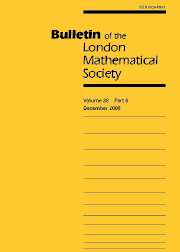Article contents
ASPHERICAL COXETER GROUPS THAT ARE QUILLEN GROUPS
Published online by Cambridge University Press: 01 January 2000
Abstract
Let Γ be a group having finite virtual cohomological dimension. Let BΓ be its classifying space, and let C(Γ) be its Quillen category, whose objects are elementary abelian 2-subgroups V of Γ and whose morphisms are restrictions of conjugacy of Γ. The group Γ is called a Quillen group if the natural map
formula here
is an isomorphism. The symmetric groups (see [8]) and the Coxeter groups of finite order (see [7]) are examples of Quillen groups.
J. H. Gunawardena, J. Lannes and S. Zarati obtained the characterization of Quillen groups in terms of unstable modules over the mod 2 Steenrod algebra [8] (see Proposition 2 below). By making use of this result, M. Errokh and F. Grazzini obtained the classification of Coxeter groups on three generators which are Quillen groups [8]. The purpose of the present paper is to obtain a necessary and sufficient condition for aspherical Coxeter groups to be Quillen groups (Theorem 1). Our result is very simple, and the previously mentioned result by Errokh and Grazzini follows easily from ours (see Example 1).
The paper is organized as follows. In Section 2, after giving relevant definitions concerning Coxeter groups, we shall state our main result. The next two sections are devoted to preliminaries. In Section 3, we shall review necessary definitions and facts concerning unstable modules over the mod 2 Steenrod algebra. In Section 4, we shall discuss the Leray spectral sequences converging to the cohomology of Coxeter groups. The proof of Theorem 1 will be given in Section 5. In Section 6, we shall give examples illustrating Theorem 1.
Notation. The cardinality of a finite set X is denoted by [mid ]X[mid ].
- Type
- NOTES AND PAPERS
- Information
- Copyright
- © The London Mathematical Society 2000
- 2
- Cited by


